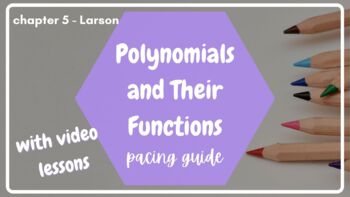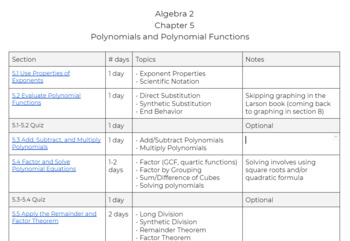MsHongx3
1 Follower
Grade Levels
7th - 12th, Higher Education, Adult Education, Homeschool
Subjects
Resource Type
Standards
CCSSHSA-APR.A.1
CCSSHSA-APR.B.2
CCSSHSA-APR.B.3
CCSSHSA-APR.D.6
CCSSHSA-APR.D.7
Formats Included
- PDF
Pages
1 page
MsHongx3
1 Follower
Description
Pacing Guide for Algebra 2
Polynomials and Polynomial Functions
(Chapter 5 in the Larson Textbook)
In this pacing guide, you will find a video link for every lesson in the chapter, the number of days it takes for me to teach each section, and topics covered in each section.
Total Pages
1 page
Answer Key
N/A
Teaching Duration
N/A
Report this resource to TPT
Reported resources will be reviewed by our team. Report this resource to let us know if this resource violates TPT’s content guidelines.
Standards
to see state-specific standards (only available in the US).
CCSSHSA-APR.A.1
Understand that polynomials form a system analogous to the integers, namely, they are closed under the operations of addition, subtraction, and multiplication; add, subtract, and multiply polynomials.
CCSSHSA-APR.B.2
Know and apply the Remainder Theorem: For a polynomial 𝘱(𝘹) and a number 𝘢, the remainder on division by 𝘹 – 𝘢 is 𝘱(𝘢), so 𝘱(𝘢) = 0 if and only if (𝘹 – 𝘢) is a factor of 𝘱(𝘹).
CCSSHSA-APR.B.3
Identify zeros of polynomials when suitable factorizations are available, and use the zeros to construct a rough graph of the function defined by the polynomial.
CCSSHSA-APR.D.6
Rewrite simple rational expressions in different forms; write 𝘢(𝘹)/𝘣(𝘹) in the form 𝘲(𝘹) + 𝘳(𝘹)/𝘣(𝘹), where 𝘢(𝘹), 𝘣(𝘹), 𝘲(𝘹), and 𝘳(𝘹) are polynomials with the degree of 𝘳(𝘹) less than the degree of 𝘣(𝘹), using inspection, long division, or, for the more complicated examples, a computer algebra system.
CCSSHSA-APR.D.7
Understand that rational expressions form a system analogous to the rational numbers, closed under addition, subtraction, multiplication, and division by a nonzero rational expression; add, subtract, multiply, and divide rational expressions.



